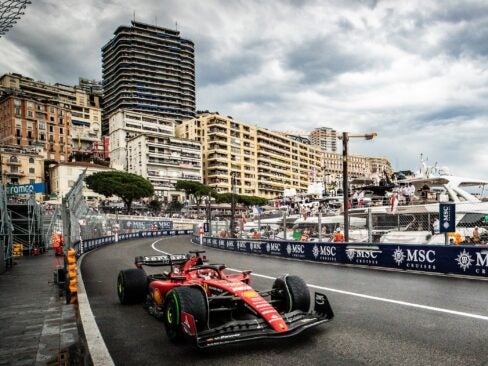Its sculpted titanium case middle and integrated rubber strap combine with a white ceramic bezel to frame the highly architectural array of tourbillon carriage and second ‘GMT’ time-zone display inside – case and movement in perfect harmony. New for 2014, however, is the flash of pure white centre-stage: an intricately machined upper bridge made of white ceramic – only possible now, thanks to Audemars Piguet’s ongoing advances in materials science.
 Bright, white, sleek and powerful, the Royal Oak Concept GMT Tourbillon, presented for the first time at the Salon International de la Haute Horlogerie 2014 (SIHH) in Geneva this week, is a watch for avant-garde collectors and connoisseurs that brooks no compromise in either technical or aesthetic terms.
Bright, white, sleek and powerful, the Royal Oak Concept GMT Tourbillon, presented for the first time at the Salon International de la Haute Horlogerie 2014 (SIHH) in Geneva this week, is a watch for avant-garde collectors and connoisseurs that brooks no compromise in either technical or aesthetic terms.
THE CONCEPT EVOLUTION
The Royal Oak Concept was first unveiled in 2002 as an avant-garde, 30th-anniversary tribute to Audemars Piguet’s legendary octagonal Royal Oak – designed by Gérald Genta as the world’s first luxury watch in stainless steel.
The Concept’s ultra-hard Alacrite 602 case was more rounded to highlight Genta’s signature octagonal bezel and its eight hexagonal screws. The dial was left off, exposing the advanced micro-mechanics ticking within. All these revolutionary design codes have persisted throughout the Concept series, from 2008’s Royal Oak Carbon Concept Tourbillon and Chronograph – an ultra-light timepiece that was the first to combine a forged-carbon case and movement mainplate – to the Royal Oak Concept GMT Tourbillon of 2011, with ultra-light, ultra-resistant titanium case and black-ceramic octagonal bezel, pushpieces and crown.
This year’s Royal Oak Concept GMT Tourbillon features a white ceramic bezel, crown and pushpieces instead of black, all heightening the contrast with the titanium case middle. However, in typical, trailblazing style, the Manufacture has now gone one step further and incorporated ceramic into the movement itself, replacing the blackened upper bridge of Calibre 2913 with white ceramic. As a result, the new Calibre 2930 is visually transformed, its dazzling, hourglass-shaped bridge further enlivened by the double symmetry of the tourbillon bridges and GMT display.
MATERIALS KNOW-HOW
White ceramic is about nine times harder than steel, meaning the manufacture of the Royal Oak Concept GMT Tourbillon’s bezel, pushpieces, crown and especially its intricately shaped upper bridge was a complex and lengthy process.
Ceramic is an almost totally scratchproof composite material that can be scratched only by diamonds, calling for the use of special milling-cutter machines equipped with diamond-tipped tools. Treating the roughed-out surfaces and edges to a polished or satin-brushed finish represents a daunting technical challenge, due to ceramic’s inherent resistance to abrasion. It takes around 8 hours to make the Royal Oak Concept GMT Tourbillon’s bezel, compared with 45 minutes if it were steel, calling upon all the savoir-faire of the watchmakers and engineers. As well as giving an exceptionally smooth final appearance, ceramic has a practical purpose, displaying extreme resistance to wear.
Similarly, the titanium used for the case middle and sapphire surround is ultra strong, comfortable to wear twice and as light as steel – advantageous for a watch of such generous 44mm proportions. Further demonstrating Audemars Piguet’s deeply entrenched knowledge of high-tech metals and materials, the inner flange circling the dial is made of lightweight aluminium, hardened by anodisation.
This daring cocktail of ceramics and metals is just the latest chapter in Audemars Piguet’s ongoing quest to push the envelope when it comes to materials science – a quest that started over 40 years ago with the Manufacture’s most daring move of all, using steel in a luxury watch for the very first time.
Source: Audemars Piguet









